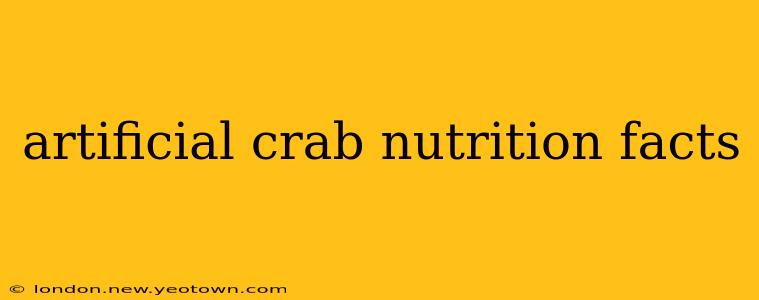Let's be honest, artificial crab meat—that delightful imitation of the real deal—often finds its way onto our plates, adding a touch of seafood flavor to our meals without the hefty price tag. But beyond its taste and affordability, what's truly inside this culinary chameleon? Understanding the nutritional composition of artificial crab can help you make informed choices about incorporating it into your diet. This isn't just about calories; it's about understanding the ingredients, their potential benefits, and any potential drawbacks.
What is Artificial Crab Meat Made Of?
Artificial crab meat, also known as imitation crab meat or surimi, isn't actually crab at all. It's a clever concoction primarily made from surimi, a paste produced from finely minced white fish, usually Alaska pollock or other similar species. This fish paste is then mixed with various additives to achieve that familiar crab-like texture and flavor. These additives can include starch (often potato starch or tapioca starch), egg white, sugar, salt, and flavorings including crab extract (though in small quantities). Some brands also include food coloring to mimic the crab's natural hue.
Is Artificial Crab Healthy?
The healthiness of artificial crab is a nuanced question. While it's not a direct source of crab's nutrients, it still offers some nutritional value and can be part of a balanced diet. It's lower in fat compared to many other processed meats, and it's a relatively good source of protein. However, the added ingredients – starches and sugars – increase the carbohydrate content, and the sodium content can be quite high depending on the brand.
How Many Calories are in Artificial Crab?
A typical serving (around 3 ounces or 85 grams) of artificial crab generally contains between 70 and 100 calories. The exact calorie count varies across brands and preparation methods.
How Much Protein is in Artificial Crab?
The protein content is usually around 7-10 grams per serving, providing a modest contribution to your daily protein intake. This is a considerable amount for such a low-calorie food, but one needs to consider the source.
Is Artificial Crab High in Sodium?
Yes, this is a significant consideration. Many brands add a substantial amount of salt to enhance flavor. Individuals watching their sodium intake, particularly those with high blood pressure, should be mindful of this and check nutrition labels carefully.
Does Artificial Crab Contain Mercury?
Unlike some real seafood, artificial crab's mercury content is generally low, as it primarily uses white fish that are not known for high mercury levels. However, always check the specific fish used in your chosen brand.
What are the Benefits of Artificial Crab?
- Affordability: It's a significantly cheaper alternative to real crab meat.
- Lower in Fat: Compared to some other protein sources, it's relatively low in fat.
- Versatile: It can be used in a wide array of dishes, from salads and appetizers to stir-fries and pasta dishes.
- Good Source of Protein (Relatively): Contributes to your protein intake.
What are the Drawbacks of Artificial Crab?
- High Sodium Content: Many brands are high in sodium.
- Processed Food: It undergoes significant processing, meaning it's not a whole food.
- Added Sugars and Starches: These contribute to the overall carbohydrate content and may not be ideal for those watching their sugar intake.
- Not a Significant Source of Omega-3 Fatty Acids: Unlike some seafood, it doesn't contain substantial amounts of these beneficial fatty acids.
Making Informed Choices: Tips for Consumers
When choosing artificial crab meat, pay close attention to the nutrition label. Look for brands that are lower in sodium and added sugars. Consider incorporating it into your diet in moderation as part of a balanced approach. Remember, culinary creativity can minimize the reliance on added sodium through careful preparation methods.
By understanding the nutritional content and ingredients of artificial crab, you can enjoy this convenient and versatile food while making informed choices that align with your health goals. Remember, moderation and a balanced diet remain key factors in overall wellness.

